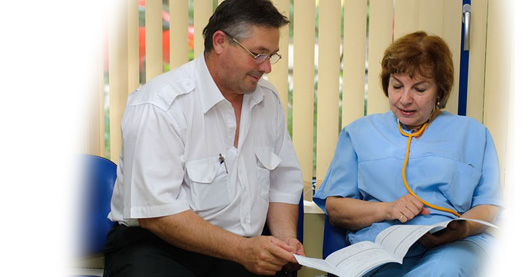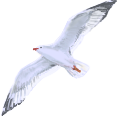Cardiovascular system
This section explains in detail the role of the heart, the blood vessels and the blood. By means of your cardiovascular system the vital substances are carried to the organs that need them.
Your cardiovascular system carries oxygen and food substances between the tissues and organs. Besides, it helps the excretion of waste substances from your organism.
The heart, the blood vessels and the blood form a complex network, where the plasma and blood cells are carried to your organism. These substances are carried to the blood through the blood vessels and the blood sets the heart to motion, which operates as a pump.
The blood vessels of the cardiovascular system form two major sub-systems: vessels from the small and large channels of blood circulation.
The vessels from the small channel of blood circulation carry blood from the heart to the lungs and vice versa.
The vessels from the large channel of blood circulation connect the heart with all other parts of the body.
Blood vessels
The blood vessels carry the blood between the heart and the different tissues and organs of the body.
Blood vessels can be:
• arteries
• arterioles
• capillaries
• venules and veins
Arteries and arterioles carry the blood from the heart. Veins and venules supply the blood back to the heart.
Arteries and arterioles
The arteries carry the blood from the heart chambers to other parts of the body. They have a big diameter and thick elastic walls that can bear intense blood pressure.
Before connecting to the capillaries the arteries are divided into thin branches, called arterioles.
Capillaries
The capillaries are the smallest blood vessels that connect the arterioles with the venules. Due to the very thin walls the capillaries exchange food and other substances (oxygen, carbon dioxide) between the blood and the different tissue cells. Depending on the needs for oxygen and other food substances the different tissues have a different number of capillaries.
Tissues such as the muscles, for example, use a great amount of oxygen, so there is a thick network of capillaries. On the other hand, tissues with a delayed metabolism (such as cornea, cuticle, etc.) have no capillaries at all. The human body has a great number of capillaries: if we are to imagine them spread in a line, their length would be around 40-90 thousand km.
Venules and veins
Venules are miniature vessels, connecting the capillaries with the veins, which are bigger than the venules. Veins are located almost in parallel with the arteries and carry the blood back to the heart. Unlike arteries, veins have thinner walls with a less muscular and elastic tissue.
Importance of oxygen
The cells in your organism need oxygen and it is the blood that carries the oxygen from the lungs to the different organs and tissues.
When you breathe, the oxygen passes through the walls in special air sacs (alveoli) in the lungs and is attached to special blood cells called erythrocytes.
The oxygen-enriched blood along the small channel of blood circulation reaches the heart, which ejects it along the large channel of blood circulation in the other parts of the body. When it reaches different tissues, the blood gives in the carried oxygen and takes away the carbon dioxide.
Saturated with carbon dioxide the blood gets back to the heart, from where it ejects back to the lungs. There the blood gives away the carbon dioxide and is again saturated with oxygen, thus closing the complete cycle of gas exchange. The blood saturated with carbon dioxide gets back to the heart, from where it ejects to the lungs. There the blood frees from the carbon dioxide and saturates again with oxygen, thus closing the complete gas exchange cycle.
Blood
The organism of an adult contains an average of 5 litres of blood. The blood is composed of a liquid part and blood cells. The liquid part is called plasma and the blood cells are erythrocytes, leucocytes and thrombocytes.
Plasma
The plasma is a liquid with blood cells. It consists of 92% water with a complex mixture of proteins, vitamins and hormones.
Erythrocytes
Erythrocytes constitute more than 99% of the blood cells. The blood is red in colour because of the protein contained in the erythrocytes which is called hemoglobin.
It is the hemoglobin that carries the oxygen and spreads it throughout the whole organism. At the moment of oxygen binding a bright red substance is produced. It is called oxyhemoglobin. After the release of the oxygen a darker substance is produced. It is called deoxyhemoglobin.
The contents of erythrocytes in the blood is measured in terms of quantity in one cubic millimeter. Healthy people have 4,2 to 6,2 mln. erythrocytes in one cubic millimeter.
Leucocytes
Leucocytes or white blood cells are the warriors that protect your organism from infections. These cells protect the organism by means of phagocytosis of the bacteria or by means of production of special substances which destroy the infection stimulants.
Leucocytes mainly operate outside the blood system but they reach the infected sections namely through the blood. The content of leucocytes in the blood is also measured by their quantity in one cubic millimeter. Healthy people have 5-10 thousand leucocytes in one cubic millimeter. Doctors keep track of the measurement, which is often a sign of a disease or an infection.
Thrombocytes
Thrombocytes are cell fragments smaller than half an erythrocyte. Thrombocytes help “repair” the blood vessels as they attach to the damaged walls. They also participate in the blood clotting, thus preventing the blood inflow or the blood outflow from the blood vessel.
Heart
Despite its small size (approximately as big as a clenched fist), your heart pumps out about 5-6 l of blood per minute even while at rest!
The human heart is a muscle pump divided into four compartments. The two upper ones are called atriums. The two lower ones are called chambers.
The atriums gather the inflowing blood and eject it to the chambers. Then the blood ejects from the heart into the arteries and from there it reaches all other parts of the body.
The atriums and chambers are divided by a septum. There is a valvular opening /tricuspid valve/ between the right atrium and the right chamber. There is another valvular opening /mitral valve/ between the left atrium and the left chamber. Between the left chamber and the aorta there is one more valvular opening /aortic valve/.
How the heart works
The blood flow from the venous network and through the pulmonary veins reaches the right atrium and from there through the tricuspid valve it reaches the right chamber. By means of its rhythmic contraction the right chamber ejects the blood to the lungs, where it is oxygenated and secretes the carbon dioxide. Afterwards the blood enriched with oxygen and by means of blood vessels is flown into the left atrium, which contracts upon fulfillment and through the mitral valve ejects the blood in the left chamber. By means of the rhythmic contraction of the left chamber the blood is ejected in the aorta through the aortic valve, thus carrying the oxygen to all cells in the body.
Heart valves
The valves act as gates, enabling the blood to move from one part of the heart to another and from there to the blood vessels connected to the heart. The valves in the heart are: tricuspid, pulmonary, mitral and aortic valve.
Tricuspid valve
The tricuspid valve is located between the right atrium and the right chamber. When the valve opens, it carries the blood from the right atrium to the right chamber. The valve hinders the reverse flow of the blood to the right atrium by closing during the contraction of the right chamber. It consists of three flaps.
Pulmonary valve
When the tricuspid valve is closed, the blood from the right chamber outflows only towards the trunk of the pulmonary arteries. The pulmonary trunk is divided into left and right pulmonary arteries which lead respectively to the left and right lung. The entrance to the arteries is covered by the pulmonary valve. It consists of three flaps which are opened at the time of contraction of the right chamber and are covered upon its release. The valve releases the blood from the right chamber in the pulmonary arteries, but hinders its reverse flow.
Mitral valve
The mitral valve regulates the blood flow from the left atrium in the left chamber. It closes at the moment of the left chamber contraction. The mitral valve regulates the blood flow from the left atrium in the left chamber. It closes at the moment of contraction of the left chamber. The mitral valve consists of two flaps.
Aortic valve
The aortic valve consists of three flaps and covers the entrance to the aorta. The valve carries blood to the aorta from the left chamber at the moment of its contraction and hinders the reverse flow of the blood from the aorta to the left chamber upon its contraction.


